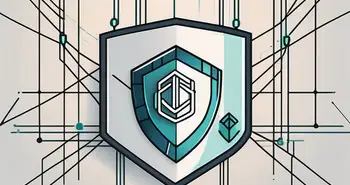A Guide to Blockchain Interoperability

Blockchain technology has revolutionized the way we think about transactions and data security. However, as the industry continues to grow, a new challenge has emerged: blockchain interoperability. In this ultimate guide, I will take you through everything you need to know about blockchain interoperability, its technical aspects, different types, challenges, and the future it holds.
Understanding Blockchain Interoperability
Blockchain interoperability refers to the ability of different blockchains to communicate and share information with each other. It is a crucial factor in maximizing the potential of blockchain technology and creating a connected ecosystem. Without interoperability, blockchains remain isolated islands of data, limiting their effectiveness and hindering mass adoption.
Defining Blockchain Interoperability
Blockchain interoperability can be defined as the seamless exchange of data and assets across different blockchain networks. By enabling interoperability, we can overcome the limitations of individual blockchains and unlock new possibilities for shared use cases and collaboration.
The Importance of Interoperability in Blockchain
Interoperability is crucial for blockchain technology to reach its full potential. It allows for the creation of decentralized applications (dApps) that can leverage multiple blockchains, thereby enhancing scalability, efficiency, and user experience. Interoperability also enables the transfer of assets and data between different blockchains, fostering collaboration and innovation.
Expert Advice: As an expert in the blockchain industry, I have witnessed the significant impact of interoperability firsthand. It opens up a world of possibilities and accelerates the pace of innovation. My advice to businesses and developers is to prioritize interoperability when building blockchain solutions, as it paves the way for seamless integration and scalability.
One of the key challenges in achieving blockchain interoperability is ensuring compatibility between different blockchain protocols. Each blockchain network has its own unique set of rules and consensus mechanisms, making it difficult for them to communicate with one another. However, several projects and initiatives are working towards developing standardized protocols and frameworks that can bridge the gap between different blockchains.
Another aspect to consider when discussing blockchain interoperability is the importance of security and trust. When different blockchains interact and share information, it is crucial to ensure that the data exchanged is accurate and tamper-proof. This is where cryptographic techniques such as zero-knowledge proofs and secure multi-party computation come into play, providing a layer of trust and verifiability in cross-chain transactions.
Furthermore, blockchain interoperability opens up new opportunities for cross-chain collaborations and partnerships. For example, imagine a scenario where a supply chain management system built on one blockchain can seamlessly interact with a finance platform built on another blockchain. This would enable end-to-end visibility and traceability of goods, while also facilitating seamless and secure financial transactions.
In conclusion, blockchain interoperability is a vital aspect of the blockchain ecosystem. It enables the exchange of data and assets between different blockchains, fostering collaboration, scalability, and innovation. As the blockchain industry continues to evolve, achieving interoperability will be crucial in unlocking the full potential of this transformative technology.
The Technical Aspects of Blockchain Interoperability
Now that we have a basic understanding of blockchain interoperability, let's dive deeper into its technical aspects.
Blockchain interoperability is a complex and evolving field that aims to address the challenge of connecting different blockchain networks to enable seamless communication and transfer of assets. One key aspect of blockchain interoperability is the concept of cross-chain communication, which allows transactions and data to flow securely between disparate blockchains. This interoperability is crucial for fostering collaboration and innovation in the blockchain space.
How Blockchain Interoperability Works
Blockchain interoperability can be achieved through various mechanisms, such as atomic swaps, relays, and interoperability protocols. Atomic swaps, a form of smart contract technology, enable the peer-to-peer exchange of assets between different blockchains without the need for a trusted third party. This mechanism ensures secure and efficient transactions across multiple chains.
Relays play a vital role in blockchain interoperability by acting as bridges between different networks. These relays facilitate the transfer of data and assets between blockchains, ensuring that information is transmitted accurately and securely. Interoperability protocols, like Polkadot and Cosmos, provide a standardized framework for connecting disparate blockchains through a unified network, promoting scalability and efficiency in cross-chain operations.
The Role of Smart Contracts in Interoperability
Smart contracts are integral to achieving blockchain interoperability by automating the execution of agreements and transactions between different networks. These self-executing contracts enable trustless communication channels, allowing parties to interact and transact without the need for intermediaries. By leveraging smart contracts, blockchain interoperability can be enhanced, leading to increased efficiency and transparency in cross-chain operations.
Overall, the technical aspects of blockchain interoperability are multifaceted and dynamic, driven by innovative technologies and protocols that aim to create a connected and interoperable blockchain ecosystem. As the blockchain industry continues to evolve, the importance of seamless interoperability between different networks will become increasingly paramount for unlocking the full potential of decentralized technologies.
Different Types of Blockchain Interoperability
There are various approaches to achieving blockchain interoperability. Let's explore some of the different types.
Cross-Chain Interoperability
Cross-chain interoperability focuses on enabling communication and asset transfer between multiple blockchains. It allows users to leverage the unique features and capabilities of different blockchains, expanding the functionalities of decentralized applications.
Sidechain Interoperability
Sidechains are parallel chains connected to a main blockchain. They offer scalability and privacy benefits. Sidechain interoperability allows for the transfer of assets and data between the main blockchain and the sidechains, enhancing overall network efficiency.
Interledger Protocols
Interledger protocols provide a standardized way of conducting transactions and transferring assets across different blockchain networks. They enable seamless interoperability by establishing a common language for communication.
Challenges in Achieving Blockchain Interoperability
While blockchain interoperability offers immense potential, there are several challenges that need to be addressed.
Security Concerns
Ensuring the security of interoperable blockchains is crucial. The transfer of assets and data between different networks introduces new attack vectors and vulnerabilities. Robust security measures, such as cryptographic protocols and consensus mechanisms, must be implemented to mitigate these risks.
Scalability Issues
Scaling interoperable blockchains is a complex task. As the number of connected blockchains increases, the network's capacity and transaction throughput must keep pace. Scalability solutions, such as sharding and layer 2 protocols, need to be implemented to address this challenge.
Standardization Problems
Lack of standardized protocols and frameworks poses a significant barrier to blockchain interoperability. Without common standards, achieving seamless communication and collaboration between different blockchains becomes challenging. Industry-wide cooperation and the development of interoperability standards are essential to overcome this hurdle.
Future of Blockchain Interoperability
Looking ahead, the future of blockchain interoperability is filled with exciting possibilities.
Emerging Trends in Blockchain Interoperability
New technologies and concepts, such as cross-chain bridges and multi-chain applications, are emerging to enhance blockchain interoperability. These innovations aim to simplify the process of connecting various blockchains, making interoperability more accessible and user-friendly.
Potential Impact of Interoperability on Blockchain Adoption
Blockchain interoperability has the potential to drive widespread adoption of blockchain technology. By enabling seamless collaboration and integration, interoperability removes the barriers that hinder blockchain implementation. It opens up new use cases, attracts more developers, and encourages businesses and industries to embrace blockchain solutions.
Predictions for Blockchain Interoperability
Experts believe that blockchain interoperability will continue to evolve and become a core component of the blockchain ecosystem. As more projects and initiatives focus on improving interoperability, we can expect increased connectivity between blockchains, making the vision of a truly interconnected blockchain network a reality.
FAQ
What is blockchain interoperability?
Blockchain interoperability refers to the ability of different blockchains to communicate and share information with each other. It enables the seamless exchange of data and assets across multiple blockchain networks.
Why is blockchain interoperability important?
Blockchain interoperability is crucial for maximizing the potential of blockchain technology. It allows for the creation of decentralized applications that leverage multiple blockchains, enhances scalability and efficiency, and enables the transfer of assets and data between different networks.
What are the different types of blockchain interoperability?
The different types of blockchain interoperability include cross-chain interoperability, sidechain interoperability, and the use of interledger protocols. Each type focuses on enabling communication and asset transfer between different blockchains.
What are the challenges in achieving blockchain interoperability?
Some of the challenges in achieving blockchain interoperability include security concerns, scalability issues, and standardization problems. Robust security measures, scalability solutions, and the development of interoperability standards are essential to overcome these challenges.
What does the future hold for blockchain interoperability?
The future of blockchain interoperability is promising. Emerging trends, such as cross-chain bridges and multi-chain applications, aim to simplify the process of connecting different blockchains. Blockchain interoperability has the potential to drive widespread blockchain adoption and become a core component of the blockchain ecosystem.
In conclusion, blockchain interoperability holds great promise for the future of blockchain technology. By enabling seamless communication and collaboration between different blockchains, we can unlock new possibilities and accelerate the pace of innovation. While there are challenges to overcome, the industry's focus on interoperability standards and emerging technologies signals a bright future for a truly interconnected blockchain network.
As we embrace the interconnected future of blockchain technology, take your trading experience to the next level with Morpher. With its innovative platform, Morpher.com offers you the ability to trade across various asset classes with zero fees, infinite liquidity, and up to 10x leverage. Whether you're interested in stocks, cryptocurrencies, or even niche markets like NFTs and sneakers, Morpher's unique trading experience on the Ethereum Blockchain is designed to democratize and revolutionize investing. Don't miss out on the opportunity to be a part of this transformative era. Sign Up and Get Your Free Sign Up Bonus today and join the future of trading with Morpher.

Disclaimer: All investments involve risk, and the past performance of a security, industry, sector, market, financial product, trading strategy, or individual’s trading does not guarantee future results or returns. Investors are fully responsible for any investment decisions they make. Such decisions should be based solely on an evaluation of their financial circumstances, investment objectives, risk tolerance, and liquidity needs. This post does not constitute investment advice.

Painless trading for everyone
Hundreds of markets all in one place - Apple, Bitcoin, Gold, Watches, NFTs, Sneakers and so much more.

Painless trading for everyone
Hundreds of markets all in one place - Apple, Bitcoin, Gold, Watches, NFTs, Sneakers and so much more.








